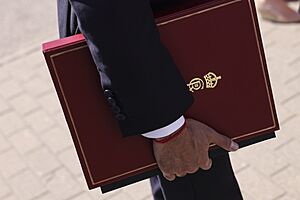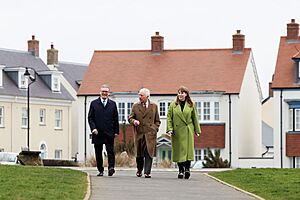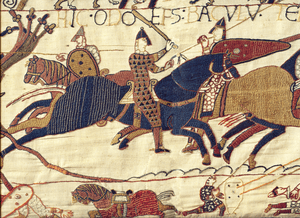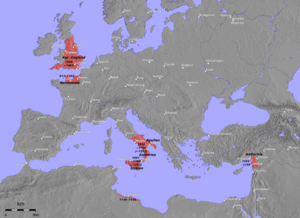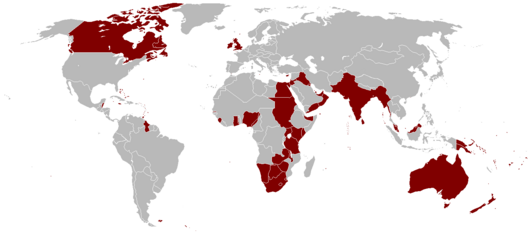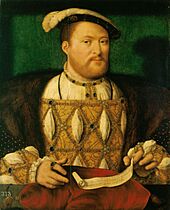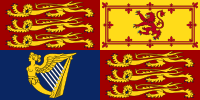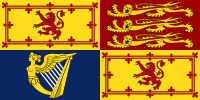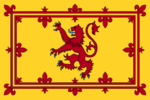Monarchy of the United Kingdom facts for kids
Quick facts for kids King of the United Kingdom |
|
|---|---|

|
|
| Incumbent | |
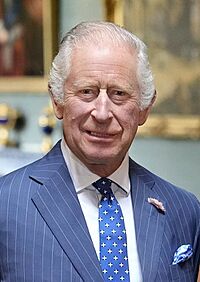 |
|
| Charles III since 8 September 2022 |
|
| Details | |
| Style | His Majesty |
| Heir apparent | William, Prince of Wales |
| Residences | |
The monarchy of the United Kingdom, often called the British monarchy, is the system of government where a hereditary monarch (a king or queen who inherits their position) is the head of state. Their powers are guided by the British constitution, which is a set of rules and traditions. This term also describes the role of the British royal family within the UK's political system. Since September 8, 2022, the monarch has been King Charles III. He became king after his mother, Queen Elizabeth II, passed away.
The King and his family have many important jobs. These include official ceremonies, diplomatic meetings, and representing the country. Even though the monarch formally leads the government (known as "His Majesty's Government"), their power is limited. They must follow laws made by Parliament and long-standing traditions. The monarch's role is mostly about things like giving out awards and choosing the prime minister. These actions are done in a fair and unbiased way. The UK government sees the monarchy as a special way to connect with other countries and promote British values. It also helps tourism and supports charities.
The British monarchy started with small kingdoms in Anglo-Saxon England and early medieval Scotland around the 10th century. These kingdoms eventually became England and Scotland. In 1066, the Normans conquered England. Later, Wales and Ireland also came under English control. Over time, documents like the Magna Carta began to limit the monarch's power. In the 16th century, English and Scottish monarchs were important in the English Reformation and Scottish Reformation, which changed religion in Britain. From 1603, England and Scotland shared the same ruler.
For a short time, from 1649 to 1660, there was no monarch. England became a republic called the Commonwealth of England after the Wars of the Three Kingdoms. After the monarchy was restored, the Glorious Revolution in 1688 brought William III and Mary II to the throne. The Bill of Rights 1689 and the Claim of Right Act 1689 further reduced the monarch's power. These laws also said that Catholics could not become monarch. In 1707, England and Scotland joined to form the Kingdom of Great Britain. In 1801, Ireland joined, creating the United Kingdom of Great Britain and Ireland.
From the 16th century, the monarch was the head of the huge British Empire. This empire covered a quarter of the world's land by 1921. Between 1876 and 1948, the British monarch was also called the Emperor of India. After World War II, most British colonies became independent. George VI and later monarchs took the title Head of the Commonwealth. This shows a free group of independent countries. The United Kingdom and fourteen other countries share the same monarch. These are called Commonwealth realms. Each country is independent, but they share the same person as their head of state. The monarch also leads the Crown Dependencies and British Overseas Territories.
Contents
The Monarch's Role in Government
In the UK's unwritten constitution, the monarch is the head of state. The monarch's image shows British authority. For example, their picture is on Bank of England notes and all British coins. The national anthem is "God Save the King". People also make promises of loyalty to the monarch.
The monarch does not directly run the government. Most of their formal powers are given to ministers or other public officials. So, even if the monarch performs state actions, like the King's Speech, these actions are based on decisions made by others. In simple terms:
- Laws are made by the King, the House of Lords, and the House of Commons working together.
- The government, led by the prime minister and Cabinet, carries out executive power. They lead the Armed Forces of the Crown and other public services.
- Judges and courts are independent of the government.
- The Church of England, which the monarch leads, has its own rules.
The monarch's role is mostly about non-political duties, like giving out honours. This has been true since the 1800s. A writer named Walter Bagehot said in 1867 that the monarchy is the "dignified" part of government, not the "efficient" (working) part.
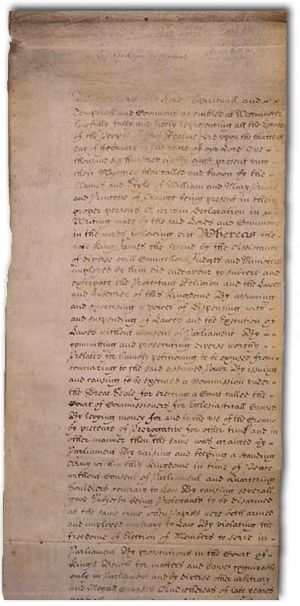
Royal Powers and How They Are Used
The monarch has certain traditional powers called the royal prerogative. These powers are usually used by ministers who are accountable to Parliament. The prime minister, not the monarch, controls how these powers are used. The monarch meets with the prime minister every week. These meetings are private. The monarch can share their thoughts but must accept the prime minister's decisions. As Walter Bagehot said, the monarch has "the right to be consulted, the right to encourage, the right to warn."
The royal prerogative is wide but has limits. Many of these powers are now used by Parliament. For example, the monarch cannot create new taxes; Parliament must approve this. Parliament can also change any royal power by passing a law.
Royal powers include appointing ministers, managing the civil service, issuing passports, declaring war, and making peace. The monarch is also the Head of the Armed Forces. They also welcome foreign ambassadors.
Choosing the Prime Minister
The monarch chooses the prime minister. By tradition, the monarch appoints the person who has the most support in the House of Commons. This is usually the leader of the party that won the most seats. The prime minister officially takes office after a private meeting with the monarch. The monarch can also dismiss the prime minister, but this has not happened since 1834. Prime ministers now leave office by resigning.
The monarch also appoints other ministers, but only on the prime minister's advice. So, the prime minister decides who is in the government. If no party has a clear majority in Parliament (a "hung parliament"), the monarch has a bit more choice. However, they would still usually pick the leader of the largest party. Since 1945, there have only been three hung parliaments.
Parliamentary Sessions
The monarch has the power to start, pause, and end Parliament sessions. Each session begins with the monarch's official summons. The new session starts with the State Opening of Parliament, where the monarch reads a speech outlining the government's plans. Pausing a session is called prorogation. Ending a parliamentary term is called dissolution, which leads to a general election. Parliaments are automatically dissolved after five years if not dissolved sooner.
A law passed in 2011 temporarily removed the monarch's power to dissolve Parliament. However, this power was given back in 2022. The monarch's power to prorogue Parliament was not affected and is a regular part of the parliamentary year.
In 1950, the monarch's private secretary, Sir Alan Lascelles, wrote that the monarch could refuse a minority government's request to dissolve Parliament under certain conditions. However, in practice, the prime minister's term usually ends due to an election loss, death, or resignation.
Other Royal Powers
For a bill passed by Parliament to become law, it needs royal assent (the monarch's approval). In theory, the monarch can refuse, but this has not happened since 1708.
The monarch has a similar role with the governments of Scotland, Wales, and Northern Ireland. They appoint the First Minister of Scotland and First Minister of Wales based on nominations from their parliaments. The monarch acts on the advice of the Scottish Government for Scottish matters. For Welsh matters, they act on the advice of the UK prime minister. The monarch can veto laws passed by the Northern Ireland Assembly if they are unconstitutional.
The monarch is seen as the "fount of justice." This means that legal actions are done in their name. For example, court cases are brought on the monarch's behalf. The law says the monarch "can do no wrong," so they cannot be charged with crimes. However, the government (the Crown) can be sued in civil cases since 1947. The monarch also has the power to pardon offenders or reduce sentences.
The monarch is the "fount of honour," meaning they are the source of all awards and titles in the UK. They create peerages (titles like Duke or Baron), appoint members to orders of chivalry, and grant knighthoods. While most honours are given on the prime minister's advice, some are the monarch's personal choice. These include members of the Order of the Garter and the Order of the Thistle.
Monarch's Legal Protection
The monarch cannot be arrested or charged with crimes. Their property also cannot be seized. However, the government (the Crown) can be sued in civil cases.
More than 160 laws protect the monarch or their property. For example, the monarch is exempt from anti-discrimination laws, health and safety rules, and many taxes. Environmental inspectors cannot enter the monarch's property without permission.
History of the Monarchy
English Monarchy's Beginnings
After Viking raids in the 800s, the Anglo-Saxon kingdom of Wessex became the strongest in England. Alfred the Great united much of England. His grandson, Æthelstan, was the first king to rule over an area similar to modern England. England became more stable in the 1000s, even with wars against the Danes. In 1066, William, Duke of Normandy, conquered England. This changed politics and society greatly. The new monarch continued to centralize power.
William's sons, William II and Henry I, ruled after him. Henry I named his daughter Matilda as his heir. After Henry's death in 1135, his nephew, Stephen, claimed the throne. Matilda challenged him, leading to a period of chaos called the Anarchy. Stephen eventually agreed that Matilda's son, Henry II, would succeed him. Henry II became the first Plantagenet dynasty king in 1154.
Many Angevin monarchs faced civil wars and conflicts with nobles. Henry II fought rebellions from his own sons. His kingdom grew into what is called the Angevin Empire. His son, Richard I, spent most of his reign fighting in the Crusades. When Richard died, his brother John became king. John's nephew, Arthur, also claimed the throne but disappeared after being captured by John.
King John's reign was difficult due to conflicts with nobles. In 1215, the nobles forced him to sign the Magna Carta. This document guaranteed certain rights for the nobility. More disagreements led to the First Barons' War. The war ended when John died in 1216. His nine-year-old son, Henry III, became king.
Later, Simon de Montfort led another rebellion against Henry III. The war ended with a royal victory, but the king agreed to call a parliament in 1265.
The next king, Edward Longshanks, was very good at keeping royal power. He conquered Wales and tried to control Scotland. However, his successor, Edward II, lost ground in Scotland and also faced problems with nobles. Edward II was forced to give up some powers in 1311 but regained control later. He was removed from power by his wife and son, Edward III, who then became king.
Edward III claimed the French Crown, starting the Hundred Years' War. He won much French land, but it was lost by 1374. Parliament also developed more during his reign, splitting into two Houses. He died in 1377, and his 10-year-old grandson, Richard II, became king. Richard II also fought with nobles. In 1399, his cousin Henry Bolingbroke took power. Richard was removed and likely murdered. Henry became King Henry IV.
Henry IV was the first king of the House of Lancaster. He spent most of his reign fighting rebellions. His son, Henry V, continued the Hundred Years' War in France. He was successful, but his sudden death in 1422 left his baby son, Henry VI, on the throne. This gave France a chance to fight back.
Henry VI was not a strong leader, and his wife, Margaret of Anjou, was unpopular. This weakened the House of Lancaster. The House of York challenged them. Even though the Duke of York died in battle, his son, Edward IV, won in 1461, overthrowing Henry VI. The Wars of the Roses continued on and off. Edward IV's son, Edward V, disappeared, likely murdered by his uncle Richard III. Finally, in 1485, Henry Tudor (from the Lancastrian side) won the Battle of Bosworth Field, where Richard III was killed.
King Henry VII married Elizabeth of York, uniting the two families. He brought back strong royal power. His son, Henry VIII, brought huge political changes. He broke away from the Roman Catholic Church and created the Church of England because he wanted a divorce.
Wales, which had been conquered centuries earlier, officially became part of England in the 1500s. Henry VIII's son, Edward VI, continued religious reforms. But he died young in 1553, causing a crisis over who would rule next. He tried to name Lady Jane Grey as his heir, but his Catholic half-sister Mary I took the throne with public support. Mary I married Philip of Spain and tried to bring England back to Catholicism. She died in 1558, and her Protestant half-sister Elizabeth I became queen. England returned to Protestantism and grew into a major world power.
Scottish Monarchy's Story
In Scotland, monarchies also appeared after the Roman Empire left Britain. Kenneth MacAlpin is often seen as the first king of a united Scotland. Scotland grew over the next two centuries.
Early Scottish monarchs did not always pass the Crown directly to their children. Instead, the monarchy sometimes switched between different family branches. This often led to violence. From 942 to 1005, seven kings were killed. In 1005, Malcolm II became king after killing many rivals. He was succeeded by his grandson, Duncan I, which was unusual. In 1040, Duncan was defeated by Macbeth, who was later killed by Duncan's son Malcolm. Malcolm III became king in 1058.
After more battles, five of Malcolm's sons and one brother became king. Eventually, the Crown went to his youngest son, David I. David was followed by his grandsons Malcolm IV and then William the Lion. William was captured by the English king Henry II and forced to accept Henry as his overlord. This agreement ended in 1189 when Richard I needed money for the Crusades. William died in 1214 and was succeeded by his son Alexander II. Both Alexander II and his son Alexander III tried to take over the Western Isles from Norway. During Alexander III's reign, Norway invaded Scotland but failed. The Treaty of Perth gave Scotland control of the Western Isles.
Alexander III died in 1286, causing a big problem over who would rule next. Scottish leaders asked King Edward I of England for help. Edward chose Alexander's three-year-old granddaughter, Margaret. But Margaret died at sea in 1290. Edward was again asked to choose from 13 people claiming the throne. After two years, John Balliol was named king. Edward treated Balliol as a lesser ruler and tried to control Scotland. In 1295, Balliol refused to obey Edward, so Edward invaded. For ten years, Scotland had no monarch during the Wars of Scottish Independence. Then, Robert the Bruce declared himself king in 1306.
Robert's efforts led to Scottish independence in 1328. But he died a year later, and his five-year-old son, David II, became king. The English invaded again in 1332, trying to restore Edward Balliol. Balliol was crowned and removed several times. David remained king for 35 years.
David II died without children in 1371. His nephew, Robert II, from the House of Stuart, became king. During Robert II's and his successor Robert III's reigns, royal power weakened. When Robert III died in 1406, his son James I was captured by the English. After a large ransom was paid, James returned in 1424. He used harsh methods to regain power and was later killed by nobles. James II continued his father's policies but died in an accident at age thirty. Regents again took power. James III was defeated in battle in 1488, leading to another boy-king: James IV.
In 1513, James IV invaded England but was defeated at Flodden Field. The king and many nobles were killed. His infant son, James V, became king, and regents ruled again. James V also fought a disastrous war with the English in 1542. His death left the Crown to his six-day-old daughter, Mary. Another regency was set up.
Mary, a Catholic, ruled during a time of big religious changes in Scotland. Protestants gained power. Mary caused concern by marrying her Catholic cousin. After his death, she married the Earl of Bothwell, who was suspected of the murder. Nobles rebelled, forcing her to give up the throne. She fled to England, and her infant son James VI became king. Mary was imprisoned and later executed by Queen Elizabeth I of England.
One Monarch for Three Kingdoms
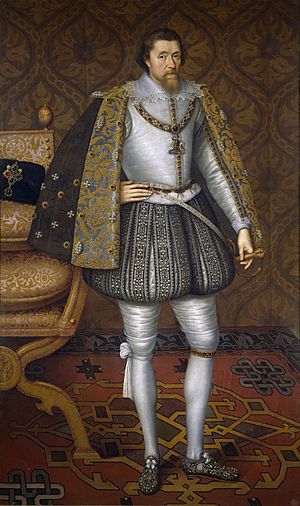
When Elizabeth I died in 1603, the Tudor rule in England ended. Since she had no children, the Scottish monarch James VI became king of England. This was called the "Union of the Crowns". England and Scotland had the same ruler, but they were still separate kingdoms. James VI and I was the first monarch to call himself "King of Great Britain." His son, Charles I, often argued with the English Parliament about royal power and taxes. He ruled without Parliament for 11 years, which caused anger. His religious policies also upset many. This led to the English Civil War in 1642.
The Civil War ended with the king's execution in 1649. The English monarchy was overthrown, and the Commonwealth of England was created. Charles I's son, Charles II, was proclaimed king in Scotland but had to flee after being defeated in England. In 1653, Oliver Cromwell, a powerful military leader, took control as Lord Protector. He ruled until his death in 1658, and his son Richard took over but soon resigned. The country wanted the monarchy back. In 1660, the monarchy was restored, and Charles II returned.
Charles II's reign saw the start of modern political parties. He had no legitimate children, and his Catholic brother, James, Duke of York, was next in line. Some in Parliament tried to stop James from becoming king. These groups became the Whig and Tory parties. James became king in 1685. He tried to give more rights to Catholics, which angered many Protestants. He also kept a large army and appointed Catholics to high positions. A group of Protestants invited James's daughter Mary and her husband William III of Orange to remove the king. William arrived in England in 1688 with public support. James fled, and William and Mary were declared joint rulers.
James's overthrow, known as the Glorious Revolution, was very important for Parliament's power. The Bill of Rights 1689 confirmed that Parliament was supreme and that English people had rights, like not paying taxes without Parliament's approval. It also said future monarchs must be Protestant. Mary II died childless in 1694, leaving William III & II as the sole monarch. By 1700, all of Mary's sister Anne's children had died, leaving Anne as the only Protestant heir. Parliament worried that James II's Catholic supporters might try to reclaim the throne. So, Parliament passed the Act of Settlement 1701. This law excluded James and his Catholic relatives from the succession and named Sophia, Electress of Hanover, and her Protestant family as the next in line after Anne. Soon after, William III & II died, and Anne became queen.
After the Union of 1707

After Anne became queen, the succession problem came up again. The Scottish Parliament was angry that the English Parliament did not ask them about choosing Sophia's family as heirs. Scotland threatened to end the shared monarchy. England responded by threatening Scottish trade. So, the Scottish and English parliaments negotiated the Acts of Union 1707. This united England and Scotland into one Kingdom of Great Britain, with succession following the Act of Settlement rules.

In 1714, Queen Anne was succeeded by her second cousin, George I, who was also the Elector of Hanover (a German state). He secured his position by defeating rebellions. George I was less involved in British government than earlier monarchs. Power shifted to his ministers, especially Sir Robert Walpole, who is often called the first British prime minister.
The next monarch, George II, saw the end of the Jacobite threat in 1746. During the long reign of his grandson, George III, Britain lost thirteen American colonies that formed the United States of America. However, British influence grew elsewhere. The United Kingdom of Great Britain and Ireland was created in 1801.

From 1811 to 1820, George III was too ill to rule. His son, the future George IV, ruled as Prince Regent. During this time, the monarchy's power continued to decline. By the time of William IV, the monarch could no longer truly interfere with Parliament. In 1834, William dismissed the prime minister, but the new prime minister lost the election, and William had to bring the old one back. The Reform Act 1832 was passed during William IV's reign, which changed how Parliament was represented. This led to more people being able to vote and the House of Commons becoming more powerful.
The final move to a constitutional monarchy happened during the long reign of Victoria. As a woman, Victoria could not rule Hanover, which only allowed male rulers. So, the link between the UK and Hanover ended. The Victorian era saw big cultural changes, new technology, and the UK becoming a major world power. Victoria was declared Empress of India in 1876. However, her reign also saw more support for a republic, partly because she mourned her husband, Prince Albert, for a long time after his death in 1861.
Victoria's son, Edward VII, became the first monarch of the House of Saxe-Coburg and Gotha in 1901. In 1917, the next monarch, George V, changed the family name to "Windsor" because of anti-German feelings during First World War. George V's reign saw Ireland split into Northern Ireland (which stayed part of the UK) and the Irish Free State (an independent nation) in 1922.
In the 20th century, the British Empire changed into the Commonwealth of Nations. Before 1926, the British Crown ruled the entire Empire. But the Balfour Declaration of 1926 gave self-government to the Dominions (countries like Canada and Australia). This meant one monarch ruled independently in each country. The Statute of Westminster 1931 made this idea stronger.
So, the monarchy was no longer just a British institution. The monarch became separately the monarch of the United Kingdom, Canada, Australia, New Zealand, and so on. One person rules several independent countries.
George V died in 1936. His son, Edward VIII, became king but caused a scandal by wanting to marry a divorced American woman. The Church of England was against remarriage after divorce. So, Edward decided to give up the throne. Parliament approved this. Edward VIII and any children he had with his new wife were removed from the line of succession. His brother, George VI, became king. George VI was a symbol of strength for the British people during World War II. In 1948, he gave up the title Emperor of India.
At first, all Commonwealth members shared the same monarch. But when India became a republic in 1950, it no longer shared the monarch. Instead, the British monarch was recognized as "Head of the Commonwealth" in all Commonwealth countries, whether they were realms or republics. This position is mostly ceremonial and is not automatically inherited. Countries that share the same monarch are called Commonwealth realms.
Monarchy in Ireland's History
In 1155, Pope Adrian IV allowed King Henry II of England to take control of Ireland. The Pope wanted the Irish church to follow Rome more closely. In 1166, the High King of Ireland exiled the King of Leinster. This king asked Henry II for help. Henry II sent Anglo-Norman nobles to help. When the King of Leinster died, one of these nobles became King of Leinster. Henry II worried this noble would create a rival kingdom. So, Henry II invaded Ireland himself, forcing the nobles and Irish kings to accept him as their ruler.
By 1542, King Henry VIII of England had broken away from the Church of Rome. The Pope's earlier grant of Ireland to the English monarch was no longer valid. So, Henry called the Irish Parliament to change his title from Lord of Ireland to King of Ireland.
In 1800, after the Irish Rebellion of 1798, the Act of Union joined Great Britain and Ireland into the United Kingdom of Great Britain and Ireland. The whole island of Ireland was part of the UK until 1922. Then, what is now the Republic of Ireland became independent as the Irish Free State. It was a separate Dominion within the Commonwealth. In 1937, it was renamed Ireland, and in 1949, it became a republic, leaving the Commonwealth and ending all ties with the monarchy. Northern Ireland remained part of the UK. In 1927, the UK changed its name to the United Kingdom of Great Britain and Northern Ireland.
Modern Views on the Monarchy
In the 1990s, support for a republic grew in the UK. This was partly due to negative news about the royal family. However, polls from 2002 to 2007 showed that about 70–80% of the British public supported the monarchy. In September 2022, after Queen Elizabeth II died, a YouGov poll showed 68% of British people felt positive about the monarchy. This might have been a reaction to the Queen's death. The poll also showed that younger people were less supportive. In May 2022, before the Queen's death, only 33% of 18-24 year olds wanted the monarchy to continue. A January 2023 survey found that 64% of UK people wanted the monarchy to continue, which was slightly lower than right after the Queen's death.
Religious Role of the Monarch
The monarch is the supreme governor of the Church of England. Archbishops and bishops are chosen by the monarch, based on the prime minister's advice. The monarch's role in the Church of England is mostly a title. The Archbishop of Canterbury is the spiritual leader. The monarch promises to protect the Church of Scotland and appoints a representative to its General Assembly. However, the monarch does not play a role in its daily running. The monarch has no formal role in the Church in Wales or Church of Ireland, which are no longer official state churches.
Who Becomes Monarch Next?

For the laws about who becomes monarch to change, all 16 Commonwealth realms must agree. Succession is decided by laws like the Bill of Rights 1689 and the Act of Settlement 1701. These laws can only be changed by an Act of Parliament. A person cannot give up their right to be monarch. The Act of Settlement says that only legitimate Protestant descendants of Sophia of Hanover (who lived from 1630–1714) can become monarch.
When a monarch dies, their heir immediately becomes the new monarch. This is why people say, "The king is dead, long live the king!" The new monarch's accession is publicly announced by a special group called the Accession Council at St James's Palace. The new monarch must take several oaths. They promise to uphold the Bill of Rights and protect the Church of Scotland. The monarch is usually crowned in Westminster Abbey by the Archbishop of Canterbury. A coronation is not needed for a monarch to rule. The ceremony usually happens months after they become monarch, to allow for preparation and a period of mourning.
Once a person becomes monarch, they are expected to rule until they die. The only time a monarch willingly gave up the throne was Edward VIII. This had to be approved by a special law in 1936. The last monarch removed against their will was James II and VII, who fled in 1688 during the Glorious Revolution.
Rules About Gender and Religion
Before October 28, 2011, sons inherited the throne before daughters, even if the daughter was older. The British prime minister, David Cameron, announced in 2011 that all 16 Commonwealth realms agreed to change this rule for anyone born after that date. They also agreed that future monarchs could marry a Roman Catholic. This was a change from a law made in 1701. However, because the monarch is the head of the Church of England, they must still be Protestant. The UK law making these changes passed in April 2013 and came into force in March 2015, after other Commonwealth realms approved it.
Even though Catholics cannot become monarch, their Protestant children can still be in the line of succession.
When a Regent is Needed
The Regency Acts allow for a regent to rule if the monarch is too young or unable to rule due to health. If a regent is needed, the next qualified person in line to the throne automatically becomes regent. Special rules were made for Queen Elizabeth II in 1953, allowing Prince Philip, Duke of Edinburgh (her husband) to act as regent if needed.
If the monarch is temporarily ill or out of the country, they can give some duties to counsellors of state. These are chosen from the monarch's spouse and the first four adults in the line of succession. The current counsellors of state include Queen Camilla; William, Prince of Wales; Prince Harry, Duke of Sussex; Prince Andrew, Duke of York; Princess Beatrice; Prince Edward, Duke of Edinburgh; and Anne, Princess Royal. While still eligible, the Duke of Sussex and Duke of York no longer perform royal duties. In November 2022, King Charles III asked Parliament to add Princess Anne and Prince Edward to the list of counsellors of state, which was approved in December 2022.
Royal Finances
Until 1760, the monarch paid for all official expenses using money from their own lands, like the Crown Estate. King George III agreed to give up these revenues in exchange for the Civil List, which was money from Parliament. This arrangement lasted until 2012. There were also grants for royal residences and travel. The Civil List covered most expenses, like staff, state visits, and events. Its amount was set by Parliament every 10 years. From 2012, the Civil List and grants were replaced by a single Sovereign Grant. This grant was initially 15% of the money made by the Crown Estate and increased to 25% in March 2017.
The Crown Estate is one of the largest property collections in the UK, worth £15.6 billion in 2022. It is held in trust, meaning the monarch cannot sell it personally. The money the Crown Estate makes for the government is usually more than the Sovereign Grant given to the monarch. For example, in 2021–22, the Crown Estate made £312.7 million, while the Sovereign Grant was £86.3 million.
The Duchy of Lancaster is another property collection, worth £383 million in 2011. Its income goes to the monarch for expenses not covered by Parliament. The Duchy of Cornwall is a similar estate that helps pay for the monarch's eldest son. The Royal Collection, which includes artworks and the Crown Jewels, is also held in trust for the nation, not owned personally by the monarch. Royal palaces like Buckingham Palace and Windsor Castle are also held in trust.
The monarch pays indirect taxes like VAT. Since 1993, the monarch has also paid income tax and capital gains tax on personal income. Money from Parliament for official duties is not taxed as income. Some people who want a republic estimate the true cost of the monarchy, including security and potential income not claimed by the state, to be around £334 million a year.
Estimates of Queen Elizabeth II's personal wealth varied. Forbes magazine estimated her wealth at US$450 million in 2010. However, no official figure was available. In 1993, a royal official said estimates of £100 million were "grossly overstated." In 1971, her former private secretary estimated her wealth at £2 million. The Sunday Times Rich List 2020 estimated Elizabeth II's personal wealth at £350 million.
Royal Homes

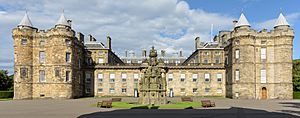
The monarch's official home in London is Buckingham Palace. Many state events, award ceremonies, and royal christenings happen here. Another official home is Windsor Castle, the largest castle in the world that is still lived in. It is used mostly on weekends, at Easter, and during Royal Ascot horse races. The monarch's official home in Scotland is the Palace of Holyroodhouse in Edinburgh. The monarch stays there for at least one week each year and for state visits to Scotland.
In the past, the Palace of Westminster and the Tower of London were the main homes for English monarchs. Later, Palace of Whitehall became important but was destroyed by fire in 1698. This led to St James's Palace becoming the main royal residence. Even though Buckingham Palace became the primary London home in 1837, St James's is still the most senior palace. It is used for formal events, like the meeting of the Accession Council. Other royal family members also use it.
Other royal homes include Clarence House and Kensington Palace. These palaces belong to the Crown, meaning they are held for future rulers and cannot be sold by the monarch. Sandringham House in Norfolk and Balmoral Castle in Aberdeenshire are privately owned by the monarch.
Royal Titles
The current monarch's full title is "Charles the Third, by the Grace of God of the United Kingdom of Great Britain and Northern Ireland and of His other Realms and Territories, King, Head of the Commonwealth, Defender of the Faith". The title "Head of the Commonwealth" is a personal title for the King, not part of the British Crown. Pope Leo X first gave the title "Defender of the Faith" to King Henry VIII in 1521. This was to reward him for supporting the Pope during the early years of the Protestant Reformation. After Henry broke from the Roman Catholic Church, the Pope took the title back, but Parliament passed a law allowing the king to keep using it.
The monarch is called "His Majesty" or "Her Majesty". The term "Britannic Majesty" is used in international agreements and on passports to show it's the British monarch. The monarch chooses their regnal name, which is not always their first name. For example, George VI, Edward VII, and Victoria did not use their first names.
If only one monarch has used a name, no number is added (e.g., Queen Victoria is not "Victoria I"). Numbers are not used for English monarchs before the Norman conquest. In 1953, some Scottish people questioned Queen Elizabeth II's use of "Elizabeth II" because there had been no "Elizabeth I" in Scotland. A Scottish court ruled that the Queen's title was her own choice. The government said that monarchs since the Acts of Union have always used the higher number from either the English or Scottish line.
Royal Symbols
The coat of arms of the United Kingdom shows symbols for England, Scotland, and Ireland. It has three lions for England, a lion for Scotland, and a harp for Ireland. The supporters (animals holding the shield) are a lion and a unicorn. The motto is "Dieu et mon droit" (French: "God and my Right"). Around the shield is a belt with the motto of the Order of the Garter: "Honi soit qui mal y pense" (Old French: "Shame be to him who thinks evil of it"). In Scotland, the monarch uses a different version of the arms, where Scotland's symbols are more prominent. The Scottish mottoes are "In Defens" and "Nemo me impune lacessit" (Latin: "No-one provokes me with impunity").

The monarch's official flag in the UK is the Royal Standard. It shows the Royal Arms. This flag is only flown when the monarch is present in a building, on a ship, or in a vehicle. The Royal Standard is never flown at half-mast (lowered) because there is always a monarch. When one dies, the next one immediately becomes monarch.
When the monarch is not at Buckingham Palace, Windsor Castle, or Sandringham House, the Union Flag is flown. In Scotland, the Royal Banner of Scotland is flown at Holyrood Palace and Balmoral Castle when the monarch is not there.
|
See also
 In Spanish: Corona británica para niños
In Spanish: Corona británica para niños


